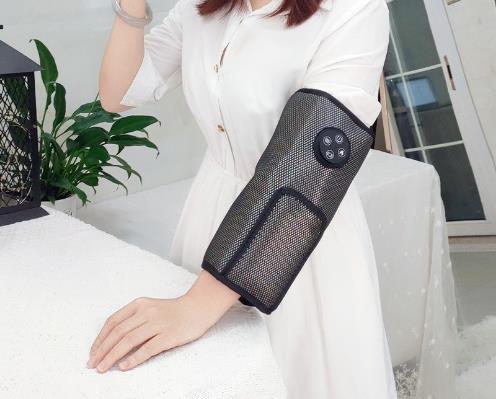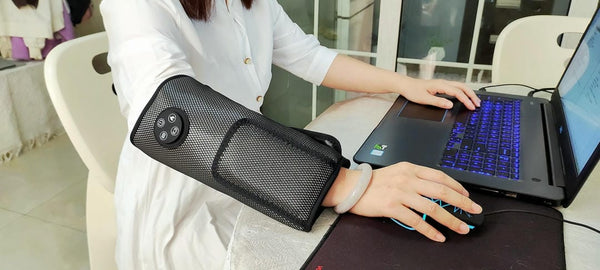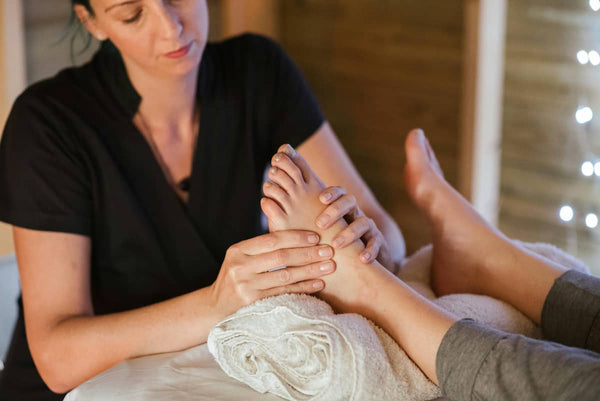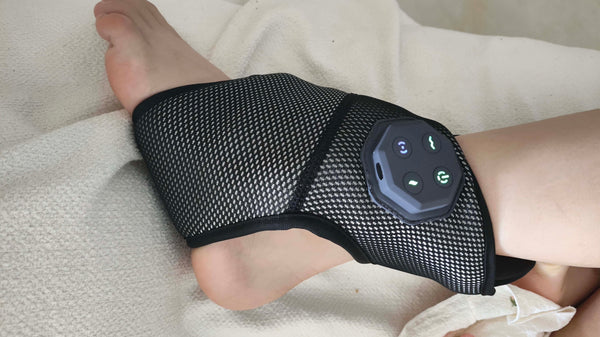 If you're a fitness enthusiast, you know your body. You push its limits, celebrate its strengths, and sometimes, you deal with the unwelcome guest of low back pain. Many seek solutions focusing directly on the lumbar spine, but what if a key contributor is hiding in plain sight, or rather, just below? We're talking about your hip flexors, and a good hip massager can be part of the solution. This article explores why these crucial muscles are often overlooked in low back pain treatment and how tools like a hip massager might offer a path to relief.
If you're a fitness enthusiast, you know your body. You push its limits, celebrate its strengths, and sometimes, you deal with the unwelcome guest of low back pain. Many seek solutions focusing directly on the lumbar spine, but what if a key contributor is hiding in plain sight, or rather, just below? We're talking about your hip flexors, and a good hip massager can be part of the solution. This article explores why these crucial muscles are often overlooked in low back pain treatment and how tools like a hip massager might offer a path to relief.
The conversation around low back pain is complex, and it's easy to see why therapists might initially focus on more "obvious" culprits in the lumbar region. However, understanding the hip flexors' role, and how a hip massager can assist, can be a game-changer. We'll delve into the reasons for this oversight, the science connecting these muscles to your back, and practical ways, including using a hip flexor release tool or even a dedicated hip massager, to address potential issues and perhaps even find that elusive instant sciatica pain relief. Learning to use a hip massager correctly is key.
Understanding the Hidden Connection: Your Hip Flexors and Nagging Low Back Pain
Your hip flexors are a group of powerful muscles located at the front of your hips, including the psoas major, iliacus, and rectus femoris. Their primary job is to lift your knee towards your chest and bend your torso forward at the hip. Think about movements like running, cycling, or even sitting for long periods – your hip flexors are constantly at work, and a hip massager can help them recover. For fitness enthusiasts, these muscles are critical for almost every lower body movement, from squats to sprints, making their health paramount for performance and injury prevention. A good quality hip massager can be a useful ally here.
Now, how do these front-of-hip muscles impact your low back? When hip flexors become tight, often from overuse in activities like running or prolonged sitting (yes, even active people sit!), they can pull the pelvis forward into an anterior pelvic tilt. This tilt increases the arch in your lower back (lumbar hyperextension), placing significant stress on the vertebrae, discs, and surrounding soft tissues. Utilizing a hip massager can help counteract some of this tightness. Over time, this chronic postural imbalance can lead to persistent low back pain, stiffness, and even contribute to nerve irritation. It's a chain reaction where tension in the front creates problems in the back, a connection that's, believe it or not, often missed. A targeted hip massager can make a difference.
- Key Hip Flexor Muscles: Psoas major, iliacus, rectus femoris, sartorius, tensor fasciae latae.
- Primary Functions: Hip flexion (lifting knee), trunk flexion, stabilizing the pelvis.
- Impact of Tightness: Can lead to anterior pelvic tilt, increased lumbar lordosis, and compensatory muscle imbalances.
- Relevance for Fitness Enthusiasts: Crucial for performance in running, jumping, lifting, and activities requiring powerful hip flexion.
- Targeted relief with a hip massager: Can aid recovery and maintain flexibility.
The Therapist's Dilemma: Why Hip Flexors Might Not Be the First Suspect
 One primary reason hip flexors are often overlooked is the sheer prevalence of direct lumbar spine issues. When a client presents with low back pain, conditions like herniated discs, facet joint syndrome, or muscle strains in the lumbar paraspinals are common and often more immediately apparent through imaging or specific orthopedic tests. This focus on the "site of pain" can sometimes lead to diagnostic overshadowing, where the true root cause, like tight hip flexors treatable with a hip massager, isn't fully investigated. It's a bit like treating the smoke without looking for the fire.
One primary reason hip flexors are often overlooked is the sheer prevalence of direct lumbar spine issues. When a client presents with low back pain, conditions like herniated discs, facet joint syndrome, or muscle strains in the lumbar paraspinals are common and often more immediately apparent through imaging or specific orthopedic tests. This focus on the "site of pain" can sometimes lead to diagnostic overshadowing, where the true root cause, like tight hip flexors treatable with a hip massager, isn't fully investigated. It's a bit like treating the smoke without looking for the fire.
Another perspective within some therapeutic circles is the "core weakness first" approach. Some therapists believe that addressing hip flexor tightness or trigger points with tools like a hip massager is less effective if underlying core instability isn't rectified. While a hip massager provides direct relief, core strength is also key. The argument is that a weak core (transverse abdominis, obliques, multifidus) allows the hip flexors to become overactive and tight as they try to compensate for lack of stability. While core strength is undeniably vital, this sequential approach might delay relief if the hip flexors, which could be managed with a hip massager, are a primary pain driver. Sometimes, releasing the tight hip flexors first can actually make it easier to engage the core correctly. It’s a bit of a chicken-and-egg scenario, and experienced therapists will often work on both concurrently.
- Focus on Lumbar Spine: Obvious disc, facet, or direct muscle issues in the back often take precedence.
- Core Weakness Priority: Some philosophies advocate for core strengthening before extensive hip flexor work, even if a hip massager could offer initial relief.
- Pain Referral Complexity: Hip flexor issues can refer pain in patterns that mimic other conditions, making diagnosis tricky.
- Time Constraints: Initial assessments may not always allow for a deep dive into every potential contributing factor beyond the primary complaint area.
- Patient education on self-care: Includes guiding on the use of a home hip massager.
Unlocking a Path to Relief: The Benefits of Addressing Hip Flexor Tension
When hip flexors are properly addressed, the benefits can be profound, especially for those suffering from low back pain. Releasing tension in these muscles can help restore a more neutral pelvic position, reducing that excessive anterior tilt. This, in turn, lessens the strain on the lumbar spine, potentially alleviating chronic aches and stiffness. For fitness enthusiasts, this can mean improved movement efficiency, better form in exercises like squats and deadlifts, and a reduced risk of compensatory injuries. Imagine your pelvis as the foundation of your torso; if it's tilted, everything above it is compromised. Regular use of a hip massager can support better alignment.
Furthermore, addressing tight hip flexors can sometimes provide almost instant sciatica pain relief. The psoas muscle, a major hip flexor, lies very close to the lumbar plexus, a network of nerves that includes the sciatic nerve. If the psoas is chronically tight or in spasm, it can compress or irritate these nerves, leading to sciatica-like symptoms such as pain, numbness, or tingling down the leg. Releasing this tension, perhaps with a targeted hip flexor release tool, a session with a skilled therapist, or even consistent use of an effective hip massager, can decompress these nerves. Many users of devices like the KLCOSY hip and shoulder Massager have anecdotally reported significant improvements in such symptoms by focusing on this often-neglected area. A versatile hip massager can be a great addition to your recovery toolkit, and a quality hip massager is worth the investment.
- Improved Posture: Reduces anterior pelvic tilt and excessive lumbar arch.
- Decreased Lumbar Strain: Alleviates pressure on discs, facet joints, and back muscles.
- Enhanced Movement Quality: Allows for better biomechanics during exercise and daily activities.
- Potential Sciatica Relief: Decompresses nerves that may be irritated by tight hip flexors, offering massage for sciatica pain benefits, often achievable with a good hip massager.
- Better Core Engagement: A released hip flexor can allow for more effective core muscle activation.
- Increased comfort with a hip massager: Daily use can reduce chronic tightness symptoms.
Tools of the Trade: How Massage and a Hip Massager Can Target Hip Flexor Issues
Effectively addressing hip flexor tightness often involves a multi-pronged approach, including stretching, strengthening exercises for antagonistic muscles (like glutes and hamstrings), and manual therapies. Massage, in particular, can be highly beneficial. A skilled therapist can use techniques like deep tissue massage, trigger point therapy, and myofascial release to manually lengthen shortened muscle fibers, break up adhesions, and improve circulation to the hip flexor region. This direct approach can provide significant relief, often enhanced when the client also uses a hip massager at home.
For ongoing maintenance and self-care, especially for active individuals, a hip massager can be an invaluable tool. These devices, ranging from simple foam rollers and lacrosse balls to more sophisticated percussive massagers or specifically designed psoas release tools like a hip flexor release tool, allow you to apply targeted pressure to your hip flexors at home with your hip massager. For instance, a quality hip and shoulder Massager with appropriate attachments can be adapted for hip flexor work. Using a hip massager can help mimic some of the benefits of professional massage, such as reducing muscle soreness, improving flexibility, and addressing trigger points before they become major problems. This is particularly useful for managing the kind of discomfort that might lead one to seek massage for sciatica pain, and a powerful hip massager can be a game changer.
- Professional Manual Therapy: Techniques like deep tissue, trigger point release, and myofascial release performed by a therapist.
-
Self-Myofascial Release (SMR): Using tools to apply pressure and release tension.
- Foam rollers: Good for larger surface areas.
- Lacrosse/tennis balls: Allow for more targeted pressure on specific trigger points.
- Specialized hip flexor release tool products: Designed to reach deep muscles like the psoas, often functioning as a type of hip massager.
- Percussive hip massager devices: Offer rapid tapping to loosen muscles; many find this type of hip massager very effective.
- Stretching: Regular, targeted stretches like the kneeling hip flexor stretch or couch stretch.
- Strengthening: Building strength in opposing muscle groups (glutes, hamstrings, core) to maintain balance.
Smart Strategies for Happy Hips: Integrating Hip Flexor Care into Your Fitness Routine
As a fitness enthusiast, proactive care is your best defense against issues like low back pain stemming from tight hip flexors. Start by incorporating dynamic stretches for your hip flexors into your warm-up routine. Think leg swings, walking lunges with a torso twist, or high knees. These prepare the muscles for activity without overstretching them cold. Post-workout, dedicate time to static stretches, perhaps followed by a session with your hip massager, to help lengthen muscles that have been working hard. This consistent attention can make a really, really big difference.
Consider integrating self-massage with a hip massager or a hip flexor release tool 2-3 times a week, or as needed based on your activity levels. When using such tools, including any type of hip massager, always start gently, especially around the sensitive psoas area. Avoid pressing directly onto bone or major arteries (you'll feel a pulse). Listen to your body; discomfort is okay, sharp pain is not. Gradually increase pressure as tolerated with your hip massager. Complement this with core strengthening exercises that focus on pelvic stability and control, ensuring your hip flexors don't have to overwork to compensate for a weak midsection. A well-rounded approach ensures your hips, and consequently your back, stay happy and healthy. Many find that a good hip and shoulder Massager can be versatile for various muscle groups, but a dedicated hip massager is often best for this specific area.
- Warm-up Dynamically: Include leg swings, hip circles, and walking lunges.
- Cool-down with Static Stretches: Focus on poses like the kneeling hip flexor stretch or pigeon pose.
-
Regular Self-Massage: Use a foam roller, ball, or a dedicated hip massager on your quads and hip flexors.
- Step 1: Lie face down and place the hip massager or ball just inside your hip bone.
- Step 2: Gently sink your weight onto the tool, searching for tender spots with your hip massager.
- Step 3: Hold on a tender spot for 30-60 seconds, or until you feel a release. Breathe deeply.
- Step 4: You can add gentle movement, like bending and straightening your knee, to deepen the release from your hip massager.
- Strengthen Opposing Muscles: Focus on glutes, hamstrings, and core stabilizers.
- Be Mindful of Posture: Pay attention to your pelvic tilt during daily activities and exercise.
- Choosing the right hip massager: Select a tool that suits your needs and pressure tolerance.
While the immediate focus in low back pain treatment often lands on the lumbar spine itself, the evidence and experience increasingly suggest that overlooking the hip flexors can be a significant misstep. Their role in pelvic alignment and overall spinal mechanics is crucial. Therapists may sideline them due to the prominence of direct spinal issues or philosophies prioritizing core work, but addressing hip flexor tightness can unlock substantial relief and improve functional movement, particularly for active individuals. Embracing a holistic view that includes hip flexor care—through targeted stretches, professional therapy when needed, and the consistent use of tools like a hip massager or a specific hip flexor release tool—which is itself a type of hip massager—can be a powerful strategy. Investing in a reliable hip massager is investing in your well-being.
Embracing a holistic view that includes hip flexor care—through targeted stretches, professional therapy when needed, and the consistent use of tools like a hip massager or a specific hip flexor release tool—can be a powerful strategy. For fitness enthusiasts aiming to perform at their best and stay pain-free, giving your hip flexors the attention they deserve with a good hip massager isn't just a good idea; it's essential for long-term back health and can even offer instant sciatica pain relief if nerve impingement is a factor. Your hips are the powerhouse of your movement; keep them happy, and your back will thank you. Consider investing in a versatile hip and shoulder Massager to support your overall muscular health. For dedicated hip flexor work, a specific hip massager might offer more targeted benefits, making it an essential tool for any serious athlete.
Frequently Asked Questions (FAQ)
Q1: How to massage hip flexor?
A: To massage your hip flexors, you can use several methods. For self-massage, lie face down and place a massage ball (like a lacrosse ball), a specialized hip flexor release tool or a well-designed hip massager. Gently lean your weight onto the tool, breathing deeply. Search for tender spots and hold pressure for 30-90 seconds until you feel a release. You can also make small movements, like gently bending and straightening your knee or rotating your leg. A foam roller can be used for the front of the thigh (rectus femoris, part of the hip flexors), but deeper muscles like the psoas often require a more targeted tool or professional help. A good hip massager with specific attachments might also be effective for this task, and choosing the right hip massager is crucial.
Q2: Can you massage hip flexors?
A: Yes, you absolutely can massage hip flexors, both through self-massage techniques and with the help of a qualified massage therapist or physical therapist. The hip flexor group includes muscles like the psoas, iliacus, and rectus femoris. While some, like the psoas, are deep and require careful, informed pressure to reach safely and effectively, they are accessible to massage. Using tools like a hip massager, massage balls, or a dedicated hip flexor release tool can facilitate self-massage with your personal hip massager. It's important to be gentle, especially when starting with any new hip massager, and to avoid pressing directly on nerves or major blood vessels.
Q3: Do massage therapists massage hip flexors?
A: Yes, many skilled massage therapists, physical therapists, and other bodywork professionals are trained to massage hip flexors. They understand the anatomy of the region and can use various techniques like trigger point therapy, myofascial release, and deep tissue massage to address tightness, adhesions, and dysfunction in these muscles. If you suspect your hip flexors are contributing to your pain (e.g., low back pain or needing massage for sciatica pain), it's a good idea to communicate this to your therapist so they can assess and incorporate appropriate hip flexor work into your treatment plan, possibly recommending a specific hip massager for home use or a particular type of hip massager best suited for your condition. They might even demonstrate how to use your hip massager effectively.
This reply is generated based on currently verifiable public information. It is recommended to cross-check key content with authoritative sources. The information provided in this article is for general informational purposes only and does not constitute medical advice. Always seek the advice of your physician or other qualified health provider with any questions you may have regarding a medical condition.




0 comments